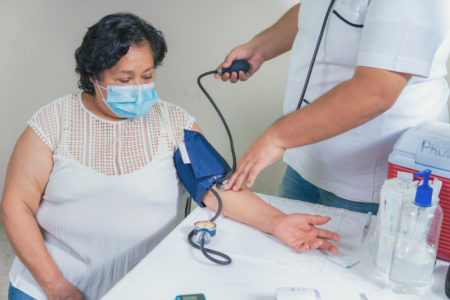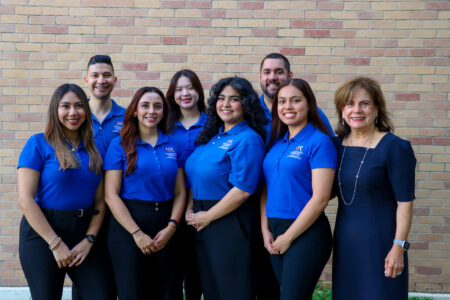
Share On Social!
Cancer can affect anyone.
But Latinos experience higher rates of infection-related cancers, ones that are preventable, than their white peers, according to a new study from the American Cancer Society (ACS).
In fact, Latinos suffer two times higher rates of liver and stomach cancers—infection-related but preventable cancers—than their white peers.
“Addressing this critical gap for Hispanic individuals in obtaining access to high-quality cancer prevention, early detection and treatment is going to be essential for mitigating the predicted growth in the cancer burden,” wrote Kimberly Miller, an ACS scientist, in the report.
“In addition, more research is needed to assess not only the impact of the COVID-19 pandemic on the utilization of cancer care, but also the impact on cancer incidence and mortality trends as COVID-19 has disproportionately affected minority populations in the U.S.”
The Report and Its Findings on Latinos and Infection-Related Cancer
In the U.S., Latinos make up 18.5% of the population, over 62 million people.
Cancer is the leading cause of death among Latinos.
The new ACS study estimated 176,000 new cancer cases and 46,000 cancer deaths will occur among Latinos in the continental U.S. and Hawaii this year.
Rates are especially high for Latinos in infection-related cancers.
“The good news is that overall cancer rates are lower in Hispanic people, but we are seeing very high rates of infectious disease-related cancers, many of which are potentially avoidable,” Miller said.
Among Latino men, the most common cancers are lung, colorectal, and liver.
Among Latinas, the most common cancers are:
- Breast cancer. Breast cancer is the leading cause of death in Latinas. While breast cancer death rates have declined in recent years, the rate of decline among Latinas is lower (1.1% per year) than their white peers (1.8% per year).
- Lung cancer. About 6,100 Latinos were expected to die of lung cancer—3,500 men and 2,600 women—in 2018.

- Colorectal cancer. There is a statistically significant disparity in stage-specific mortality of colon cancer by race, with a higher proportion of deaths from metastatic disease among Latinos than whites (48% vs. 44% respectively), a study published in Oncotarget states.
While Latino men and women are less likely than their white peers to be diagnosed with the four most common cancers (prostate, breast, lung, and colorectal), they have a higher risk of gallbladder cancer and infection-related cancers (stomach, liver, and cervical):
- An estimated 4,400 Hispanic men and women will be diagnosed with gastric cancer in 2021, and 2,200 will die from the disease. Gastric cancer rates in Latinos are approximately double those in whites.
- In 2021, an estimated 7,100 Hispanic men and women will be diagnosed with liver cancer, and 4,100 will die from the disease. Liver cancer rates in Latinos are approximately double those in whites.
- Cervical cancer, which is preventable through screening and vaccination, is 32% higher among Latinas in the 50 U.S. states and 78% higher in the U.S. territory of Puerto Rico, compared to non-Latina white women.
“Incidence varies substantially by nativity, Hispanic origin group, and duration of US residence, with rates in some groups approaching or surpassing those of NHWs, particularly among US-born Hispanic individuals,” according to the report.
Why Do Latinos Have Such a Heavy Burden of Infection-Related Cancers?
Inequitable access to cancer screening and health care contribute to Latino cancer disparities.
The new ACS study highlights that many of infection-related and other cancers could be prevented with equitable access to medical care, including cancer screening.
Screenings tests are available, according to NCI, for:
- Breast Cancer. Mammography “has been shown to reduce deaths from the disease among women ages 40 to 74, especially those over age 50.”
- Cervical Cancer. “Women between the ages of 21 and 29 should have a Pap test every 3 years. Women between the ages of 30 and 65 should have both a Pap test and an HPV test (called co-testing) every 5 years, or a Pap test alone every 3 years,” according to the American Cancer Society.”

- Colorectal (Colon) Cancer using colonoscopy, sigmoidoscopy, and stool tests. “Colonoscopy and sigmoidoscopy not only detect colorectal cancer early but also help prevent the disease in the first place.”
- Lung Cancer. Low-dose computed tomography (LDCT) “has been shown to reduce lung cancer deaths among heavy smokers ages 55 to 74.”
Still, a big issue is the lack of equitable access to healthcare.
Out of all racial/ethnic groups, Latinos have the highest percentage of uninsured people, nearly three times more than whites. Nearly half of the population in Puerto Rico receive health insurance through Medicaid, which is substantially underfunded in the U.S. territory.
COVID-19, which disproportionately harmed Latinos, only worsened the issue.
“We know that the Hispanic community was hit harder by the pandemic than many other racial and ethnic groups,” Miller of ACS said. “Many lost employment and health insurance, and were afraid to go to the doctor and get recommended cancer screenings.”
What Can Researchers Do to Address Latino Cancer?
Miller of ACS recommended reducing Latino cancer rates by increasing access to high-quality prevention, early detection and screening, and treatment services.
But that won’t be easy to do.
“While the majority of participants acknowledged the importance of PC screening and early detection, discussion centered around the barriers to both the interest in seeking medical care and the likelihood of securing it,” the researchers write.
Fortunately, new methods like texting are emerging to promote cancer screening.
We also need more diversity, inclusion, cultural competence, and less implicit bias in the cancer research and healthcare workforce.
“Hearing the patient out and asking about their fears and educating them about facts can get them more engaged,” Dr. Amanda Rivera, a radiation oncologist at Montefiore Medical Center, told US News. “As soon as I stop speaking English and start speaking Spanish, the patient becomes more alert and engaged, and more trusting of what I have to say.”
What Can You Do to Address Latino Cancer?
You can join a clinical trial!
Clinical trials are studies to find more effective treatments, which can help current cancer patients, and/or help better understand cancer to help future Latino survivors.
To engage more Latinos in research, Dr. Amelie Ramirez’s Salud America! program at UT Health San Antonio is creating Latino-focused recruitment strategies and systems for cancer and Alzheimer’s clinical trials, supported by a grant from Genentech, a member of the Roche Group. 
“Our new project will allow us to use culturally relevant digital health communications, advocacy networks, and clinical partnerships to promote health equity and advance clinical trials for cancer treatment and Alzheimer’s disease among Latinos,” she said.
If you’re in San Antonio, volunteer for:
- A cancer clinical trial at the Mays Cancer Center at UT Health San Antonio
- An Alzheimer’s disease clinical trial at the Glenn Biggs Institute for Alzheimer’s and Neurodegenerative Diseases at UT Health San Antonio
- The AHEAD Trial. For people ages 55-80, this trial aims to protect against the onset of Alzheimer’s disease. This gives you the chance to contribute to healthier futures for your mom, dad, and other family members.
- The REACH Trial. For people ages 55-89 with a diagnosis of mild cognitive impairment or Alzheimer’s disease, this trial aims evaluate a new treatment that aims to slow the effects of the disease.
You can also use the National Cancer Institute’s online search tool or call 1-800-4-CANCER to find a cancer clinical trial in your area!
By The Numbers
142
Percent
Expected rise in Latino cancer cases in coming years



